LinkedIn Marketing Strategy: 17 Tips for 2023

Learn how to use LinkedIn for business to build credibility, create a meaningful network, and glean insider expertise from experts in your industry.


Learn how to use LinkedIn for business to build credibility, create a meaningful network, and glean insider expertise from experts in your industry.




Twitter is expanding recommended tweets to all users, including people who managed to avoid them until now.
In an announcement, the company states:
“We want to ensure everyone on Twitter sees the best content on the platform, so we’re expanding recommendations to all users, including those who may not have seen them in the past.”
Twitter links to a blog post from September that explains how recommendations work.
In short – recommendations are algorithmically selected tweets from accounts you don’t follow.
By surfacing recommended tweets alongside other content in the main feed, Twitter aims to help users discover other accounts they may be interested in following.
This change doesn’t necessarily mean that people who saw recommended tweets will start seeing more of them.
Twitter’s announcement emphasizes this update applies to people who weren’t already seeing recommended tweets.
However, actual users report seeing an uptick in recommended tweets. Some are even getting recommendations in their notification tab.
My Twitter feed is at least 30% recommended Tweets.
It looks like Twitter is turning into TikTok: a personalized feed based on user behavior, not on who you choose to follow.
— Austin Rief ☕️ (@austin_rief) December 1, 2022
Tfw Twitter keeps trying to put recommended tweets in my notifications tab pic.twitter.com/JSZtlaOzsU
— Kyle Foley (@KFoleyFL) December 1, 2022
If you don’t enjoy recommended tweets or see too many, you can switch to the chronological feed and avoid them entirely.
We’d love to hear how we can make them better! In the meantime, you can switch to Latest Tweets by clicking the sparkle icon.
— Twitter Support (@TwitterSupport) November 30, 2022
The above tweet’s ratio will give you an idea of the consensus toward recommendations and the lack of options for turning them off.
A vocal contingent of Twitter users would prefer to see more relevant recommendations or have more ways to turn them off.
It was only a few months ago that Twitter CEO Elon Musk criticized the recommendation algorithm, saying he prefers the chronological feed:
Chronological tweets seem much better than what “the algorithm” suggests
— Elon Musk (@elonmusk) May 12, 2022
Could Twitter’s expansion of recommended tweets mean there are improvements to the algorithm?
You can customize your recommendations by tapping the three-dot icon next to individual tweets.
From there, you can say you’re “not interested in this tweet,” or go a step further and mute the account so Twitter doesn’t recommend it to you again.
Admittedly, it’s a cumbersome way to improve Twitter’s recommendation system, but it’s the only alternative to switching to ‘Latest Tweets.’
Featured Image: Roman Samborskyi/Shutterstock




It can be hard to know which social media trends to pay attention to and which ones to ignore. Here are the ones that matter most in 2023.
Search has come a long way since its early beginnings. Altavista and AskJeeves are long gone, and most of us can’t imagine a world without Google these days. But search continues to change. It has always been a work in progress, and it will probably always be that way. And the search engines that we’re using today might not always reign supreme. So let’s talk about the direction that search is heading in and what Schema has to do with it.
The year 2022 has already shaken search up quite a bit, with the revelation that almost 40% of Gen Z use TikTok instead of Google to search for information. Meanwhile, on more traditional search platforms we’ve seen a lot of changes too. Google and Bing have both been busy sprucing up their search results this year. With new arrivals like Google’s multisearch and Bing’s buying guides, it’s clear that search is doing anything but standing still.
So, there’s been a lot going on. But there are still many challenges for search and for SEO (besides social media and Gen Z). Ambiguous phrases and names are difficult for search engines and users to differentiate. And they can make it really hard to optimize content for search.
On top of that, expertise, authority and trust are important factors too. There’s too much spam and misinformation out there. We need search to become more precise and deliver better-quality results.
This is where we turn to structured data. Schema.org structured data, in particular. Its standardized framework enables search engines to move away from simple text-matching, allowing them to piece together the relationships between concepts. In this way, search can identify relevant phrases and content in a more semantic way.
Here’s an example. There’s more than one Joost de Valk in the world (we actually found 3 more besides the one we know). With a good Schema implementation, search engines can tell the difference between each of these people. In the future, Google could even look at your other searches to guesstimate which Joost you’re looking for. Neat, huh?
But that’s not where the story ends. Search is becoming much more experiential too. With things like knowledge graphs, Google Discover, and the Multitask United Model, search could become a lot more powerful. And a lot more personal. Whether it’s about showing your preferred sources first or offering tailored results for very specific multi-layered questions, there are huge developments in the works.
Besides making quality information more findable, what happens within search is set to change too. Google has been testing new shopping features in their search results on an almost-monthly basis in 2022. In the near future, you could be comparing and buying products directly from search, and then tracking your shipment there too.
Many of these new search features rely heavily on structured data. And in the distant future, Schema could pave the way for a much more entity-based search, with less focus on individual keywords. So don’t be hesitant about getting started with structured data — it’s probably only going to get more important as time goes on.
Whew! It’s a dizzying prospect to think about what this could mean for the future of SEO. First things first — as long as search exists, it should always be possible to optimize your content for it. Structured data is likely to play an increasingly important role in that.
If, and when, entities take a more central role in search, having content that refers to all the facts and entities related to your topic may be the way to go. It could be a case of optimizing with context more than optimizing with keywords. And of course, some things will never change. The need to create quality content is one of them — even if you’re making that content for TikTok.
Offering the best information and a seamless user experience is bound to pay off. At the very least, it’s going to help you rank in the short and long term. It could also earn you a fanbase that will be shown your content preferentially above other sources in the future. Invest in that content now, and keep an eye on the search landscape as it changes. That’s your best bet.
Want to stay up to date with all the latest news in SEO? Hear it from the experts in our monthly SEO news webinar!




Throughout the year, Google has made numerous updates and clarifications to its disapproval policies.
These updates have mostly revolved around providing more context to advertisers on the nature of ad disapprovals.
Earlier this year, Google updated its ad destination policy, unavailable video policy, and 3-strike rule.
To round out the year, Google is updating its account-level suspensions for Display and Video 360 users in December 2022.
Google is updating the main Disapprovals and Suspensions page to have a page dedicated to Display and Video 360 users.
The new page will clarify what violations would constitute an account suspension. These include:
While the new Display and Video 360 page isn’t available yet, expect to see additional context on the violations above to ensure you avoid them.
In addition to the listed violations above, Google announced that a partner account could also risk suspension.
If an advertiser within a partner account has been found to violate policies repeatedly, the account itself can be suspended. To be clear, this doesn’t mean any violation could get an account suspended.
Google’s announcement stated that if the partner account or advertiser has “repeatedly or predominantly engaged in egregious policy violations,” that would cause suspension.
Per Google’s definition, egregious violations are:
So, what can you do if that happens?
The good news is that the partner and advertiser can appeal account suspensions if hit with one.
Google is constantly reviewing its ad and account policies and violations. Consistent updates throughout the year have brought more clarity to advertisers around not only the nature of the disapproval but also more guidance on how to troubleshoot these violations.
Because Google relies on both human interaction and automation to detect violations, it’s always a good idea to spot-check your account for any disapprovals each week.
As Google rolls out the new policy page, we will update this article to include the link.
Featured Image: paper cut design/Shutterstock
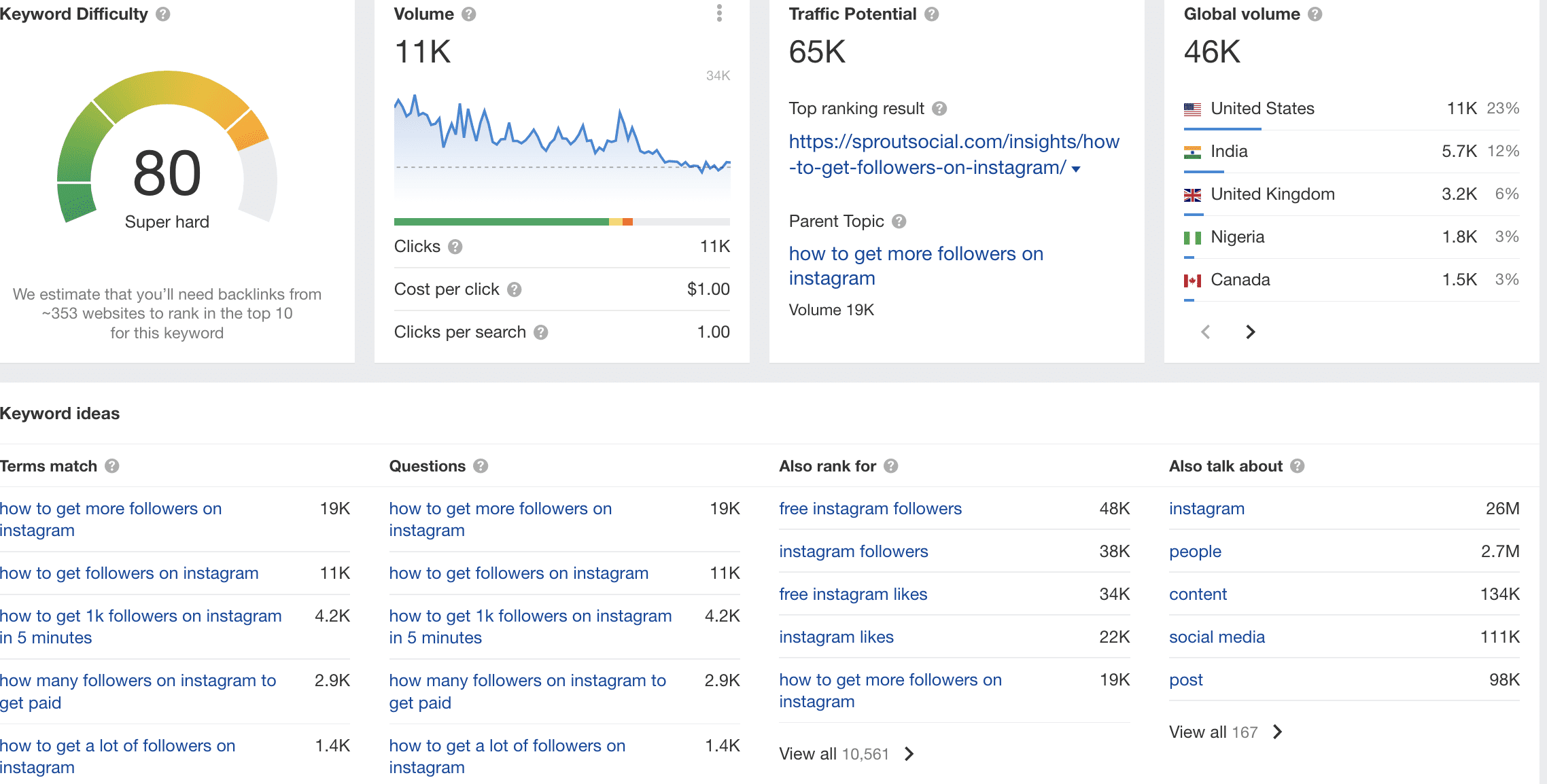
It can feel like it takes forever to build an online audience of people who actually want to read what you post, engage in your content, and actually buy the products and services you offer – especially when trying to grow organically.
Organic growth can sometimes take months or even years to reach a profitable point.
The crazy thing is most creators and business owners are still waiting on Google to hopefully bring another person to their website or page.
But what if there were a way to fix that problem?
What if there were a better and faster way to engage your organic search traffic and your social media content all at the same time?
Luckily, there is!
We created this simple six-step process to engage your organic search traffic on social media and drastically expand your organic search reach using Facebook lookalike audiences.
The steps may seem a bit much, especially if you’re new to organic growth. But don’t worry; this blog will break it down for you.
Most people starting out with keyword research already have a few keywords or phrases they think will for their business or niche. These could be keywords related to their business or brand, like [best books to read for business] or [what foods cause inflammation?].
Keyword research (keywords) or the specific words and phrases that you and your ideal audience are using related to your products, services, industry, etc.
These highly specific seed topics are very important and a great place to start.
Many times the content you want to create and rank for and what your audience is actually typing in the search bar are likely completely different.
Which is one of the most pivotal reasons to perform keyword research in the first place.
If people aren’t searching for it, then why waste time creating it in the first place?
The smartest way to avoid this is to find the exact words and phrases your ideal customers are currently searching for on Google and other major search engines.
Figuring this out isn’t as complicated as it sounds. There are a handful of keyword research tools that can help.
For example, we use Ahrefs to research the phrase, [how to get followers on Instagram].






You can see in the image above how many people are searching for this key phrase and the other relatable parent topics related to it.
When creating content for search engines, it’s essential to create content that answers one question at a time.
It’s okay to elaborate on that question, even up to a few thousand words. But don’t confuse one article with too many questions and topics.
For example, you could take these short-term and long-term keywords and write a blog post on each topic (of course, when it makes sense for your business).
If it doesn’t make sense to write a topic on each of those questions and the keywords are too relatable, then maybe it makes more sense to use this set of keywords as an H1 or H2 heading instead in the same blog post, which will also play a significant factor in search engine rankings.
Now that you understand the importance of finding the right keywords to use in your content marketing strategy, it is time to create a blog post.
When writing a blog, it is essential to remember that the goal is to get new readers to your blog consistently, which will eventually lead to a sale.
It’s also to get readers and engagement on the blog, so signals are sent to social media and the search engines to help your article get first-page rankings and rank in the first 10 blog posts on Google.
Again, this is where keyword research comes into play.
Make sure to read every blog on the first page of Google related to your keyword research. When doing so, make sure that your article outperforms each one of those blog posts or is found more valuable.
When performing keyword research correctly, it takes no time to get top rankings in Google because you know what people are searching for and how frequently they are searching for it.
Once your blog post is published on your website, it is time to wait for some people to read and engage with it.
The only thing you have to do in this step is to wait for some organic traffic to trickle in; the goal is to have around 1,000 people. If 1,000 seems like too many, try to have at least 100.
Over time when the piece of content you created starts to get search results, you can set up a pixel (this is the next step) and begin running social media ads to hack the process and get more eyeballs on your content faster.
However, let me start by saying this may not be as simple as it sounds – this is the step where most businesses get stuck and don’t know how to grow reasonably.
Most creators, businesses, and companies understand how a simple marketing funnel works, but what they don’t understand is how to continuously get newly qualified people throughout every piece of the marketing funnel.
Even so, most businesses don’t understand how to successfully intertwine multiple platforms and use social media to grow their organic search traffic or vice versa.
People have created all these great pieces of content, but they don’t understand how to use that awesome content to take them to the next level.
People don’t have enough time to create new content every single day. The pressure of having to come up with new ideas every day, film videos, or write a 2,500-word blog post often times leads to burnout.
And when you are using multiple platforms, that’s where this marketing strategy comes into play.
You have to understand how to track every person who touches your content, from the first touch to the last.
Studies have shown that it usually takes a person seven interactions or touches with a business before making a purchase.
To know how many times a person interacts with your content, it is critical to have a pixel placed on your website for accurate data tracking, leading to the next step.
Once you have published your blog post and have a small or large amount of traffic engaging with your content, it is time to set up your social media pixel on your website.






If you are unfamiliar with a pixel, here is the definition.
A pixel is a few lines of code that you copy into the header section of your website.
It works by placing and triggering cookies to track users as they interact with your website and your Facebook ads.
The pixel serves two primary purposes:
What the pixel does, in essence, is allow Facebook to track its audience on our platform; we are essentially giving Facebook access to our tracking.
If you are unsure how to create a Facebook pixel and add the Facebook Pixel to your website, follow this two-part process:
Part 1: Create A Facebook Pixel
Part 2: Add The Facebook Pixel To Your Website
Once you’ve created your pixel, you’re ready to put the Facebook pixel code on your website.
There are a few different options on how you can set this part up:
Once the tracking is in place and you fully understand your target audience’s patterns, you can begin implementing the R3MAT strategy, showing the right message to the right person at the right time with the right expectations.
Once you have your social media pixel set up, it’s time to move to the next step.
Did you know that Facebook can predict if you are pregnant before you know you’re pregnant? Or that Facebook can tell if you’re cheating on your partner? Or that you’re going to get a divorce?
It can track every scroll up or down, a swipe of the finger, every heart, repost, retweet, and knows every person, business, and profile you interact with.
Seems pretty scary, right?
But here’s where that becomes super powerful.
Facebook has an option where you can create a lookalike audience based on its tracking abilities to reach new people who are most likely to be interested in your business because they’re similar to your best existing customers.
You can create a group of people with similar likes, interests, and demographics to those already interacting with your website.
Here is how to create a Facebook Lookalike Audience:
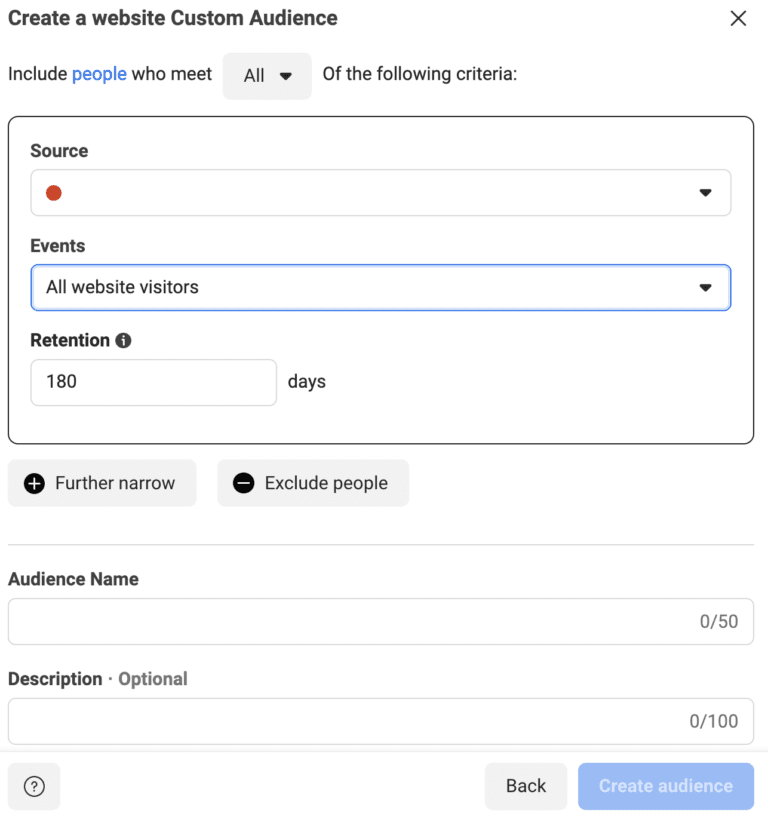





Creating this audience allows any business to create a small subset of people you can talk to any way you choose.
You can now show this audience relevant ads, move them through the sales funnel, build your relationship with them, and build your reach and frequency.
All of this is possible because Facebook is watching so many little data points all of the time.
Facebook continuously collects information about what you buy, who you search for or friend, what websites you visit, and the accounts you follow and unfollow.
Plus, thousands of other bits of personal information are gathered from public records and your social media activity.
The final step is to show relevant ads to your new lookalike audience that you just created.
To keep this process going, make sure you are consistently showing your lookalike audience(s) new relevant content that meets them at every point in their buyers’ journey.
Meaning you will hit them with new or recycled content (and the kind your audience likes to engage with) at the awareness stage, consideration stage, and decision stage of the buyers’ journey.
When you complete this six-step process, you are officially taking your organic search and lighting it on fire.
Make sure you continue to repeat this simple six-step process to engage your organic search traffic on social media over and over to see the best results.
Repeat everything from performing new keyword research to creating new content and setting up your new pixel to running new ads to the piece of content to a saved or new audience.
This doesn’t mean you must change what’s working, but maybe take a few clips out of your existing content and show that to your audience.
Break larger pieces of content down into smaller segments to create new pieces of micro-content out of your current existing content.
More Resources:
Featured Image: oatawa/Shutterstock
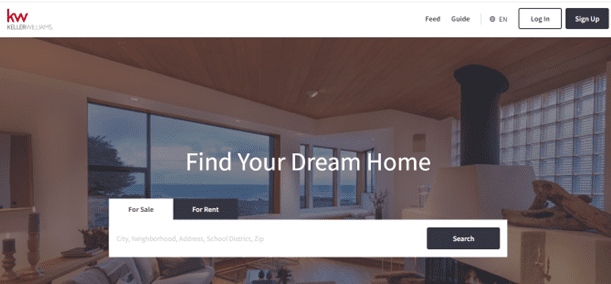
Sixty percent of realtors search for leads daily.
There are more than 3 million active real estate licenses in the U.S.
These numbers paint a clear picture of how the real estate industry is: competitive and difficult to survive in.
In this situation, you need solid real estate marketing strategies in place to drive lead generation, and help your business build its client base and survive in a cut-throat niche.
It’s worth remembering that high-quality lead generation begins with effective marketing.
So, in this article, we will discuss eight practical real estate marketing strategies, along with examples to help you generate more leads and foster sustainable business growth.
Trust is the ultimate selling factor, especially in real estate.
Marketing helps build that trust.
Apart from trust, your marketing efforts also help generate qualified leads that can be the anchor your real estate business needs to survive in the competitive realty arena.
Below are top real estate marketing ideas that, if applied properly, can promise to take your business to new heights:
Forty-four percent of buyers start looking online.
And your real estate marketing plan can be only successful if you can dial in on your audience with an optimized web presence.
Merely having a website isn’t enough, given that 88% of users won’t return to a website if they have had a bad experience.
You will need to work on your website’s user interface (UI) and user experience (UX) to ensure it serves your business the way you want it to.
Working on your web UX means enhancing numerous areas of your website like structure, content, navigation, load speed, and more.
Build your website’s structure intuitively. Perform audience research to understand the first thing your prospects would want to look for as they visit your website.
Realty company Keller Williams’ website is a good example of how a website’s structure should be.
The web developers were intuitive enough to know their prospects would come in looking for real estate listings. So they have placed the search bar right on the home page, above the fold.






Next, make sure your website’s content tells your prospects how your services will add value to their life. In other words, talk about the benefits of your services in a clear, concise manner.
Check out how Houwzer has efficiently grabbed attention right from its home page, simply through content:






Also, make the website easy to navigate. Don’t make the structure too complicated or confusing for the website visitors.
Additionally, optimize your website’s load speed.
How fast your website loads influences how many sales it will help generate.
A website’s conversion rate drops by up to 5% with each second that the website delays in loading. So, no matter how fantastic your website is, it won’t do you much good unless it loads fast.
There are numerous ways you can increase your website’s load speed.
Your hosting service significantly affects your load speed, so opt for a performance-optimized hosting solution.
A real estate website may have many images. These images can drag your website’s load speed down.
This doesn’t mean you need to delete your images. Compress and optimize them so they weigh light on your website and your website can load fast.
Also, remove any unnecessary content, spaces, characters, and elements from your website.
Finally, optimize your website for search engines.
Most of the ranking factors will be met once you work on your website’s UX.
But you will still need to work on on-page and off-page optimization to have a better chance of ranking higher in the search results.
Listings are exceptionally important for the success of your real-estate business.
People don’t shop for homes online, but they do look for them on the internet, and this becomes an important factor in choosing a real estate agent.
Therefore, your prospects will expect an optimized, detailed property listing on your website.
Include high-quality property images, video tours, price range, amenities, and all the details your prospects might be interested in while creating your property listings.
Trompeter Real Estate presents an excellent example of what an optimized listing should look like:






Social media generates the highest number – 52% – of high-quality real estate agents’ leads. This is perhaps why a whopping 90% of realtors use Facebook to promote their businesses.
These numbers clearly indicate that social media is an unmissable arena if you want to establish a thriving real estate business.
If you are looking for the right platforms, Facebook, Instagram, and LinkedIn are popular for real estate marketing.
Facebook and Instagram can help you connect with your audience and promote your business explicitly, while LinkedIn will help you implicitly by presenting you as a professional, credible real estate agent.
Once you build your social media profiles, make sure to optimize them. Fill all the required fields with correct and relevant information so your target audience can find your business.
This budding real estate agent (@hearthrealtygroup) has built a well-optimized Instagram handle.
Stay active on your social accounts by posting as frequently as you can.
You can stay active on Instagram by posting to your Stories more often, and sharing posts to your grid every now and then.
On Facebook, you can stay active by interacting with your followers, replying to comments, and posting on real estate groups.
Make sure your content is not too salesy.
Ideally, 80% of your content should be helpful, educational, and relevant. The remaining 20% of it can be commercial.
You can also post about your successful closed deals on these social profiles to build credibility, like Chad Carroll (@chadcarroll) does.
Finally, use optimized hashtags, especially on Instagram.
You can create optimized hashtags by checking out the hashtags other top realtors use and customizing them according to your locality.
You can see how this realtor from New Jersey (@gregletson_njrealtor) has used hashtags to promote his listing.
Social ads are another powerful source for generating quality real estate leads. Once you have built a solid social media presence, you can invest in ads.
Perform audience research beforehand to run targeted social advertising campaigns.
Social media platforms offer excellent ad targeting facilities, and you can capitalize on them only if you have a good understanding of your prospects.
Since you are spending money on these ads, you want to make sure they drive the right results.
So, create appealing advertisements that reflect the value your realty service will add to the client’s life. Ideally, add a testimonial or two, or create an ad based on client reviews.
Finally, include a CTA button on your ads to channel social media traffic to your website like the realtor in the example below has done:






A majority of searches for real estate agents are local.
People look for realty businesses with search terms like “Real estate agents near me” or real estate agents [city name],” etc.






Google has a dedicated business listing to display local businesses. And all the businesses that appear in this listing have a Google Business Profile (GBP).
If you haven’t already, create or claim your GBP listing.
It is an excellent source for driving web traffic and business exposure.
An optimized GBP profile acts as a second home page and displays your business’s reviews and ratings, contact number, address, and business hours. This is why it has the potential to generate high-quality real estate leads.
You can create a similar GBP profile by visiting Google.com/business.






Content marketing helps generate demands/leads, according to 67% of marketers. Moreover, 82% of marketers are actively investing in this area.
High-quality, valuable content can help your business build trust with your prospects. It also helps you establish your presence as an industry thought leader.
Any business that wishes to thrive in this era cannot stand to ignore content marketing.
As a real estate business, you can create a variety of content to fuel your content marketing efforts that could align with real estate marketing videos as well.
Start with creating a blog section on your website. Find out what your prospects are struggling with and create content addressing their problems and offering solutions.
The Zillow Blog offers a good example of how real estate blogs should be:
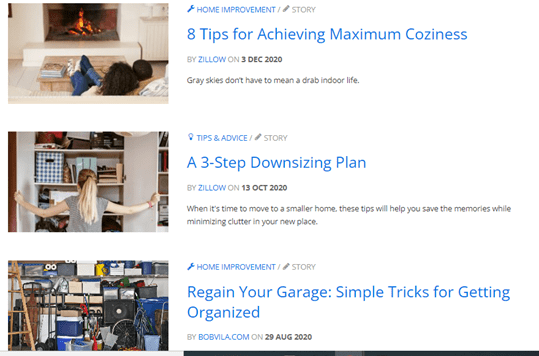





Create your YouTube channel and post helpful video content there. Your YouTube content can include home tours, area tours, and other educational content.
This Florida-local realtor has built a remarkable YouTube channel with lots of helpful content and just the right copy to attract viewers:
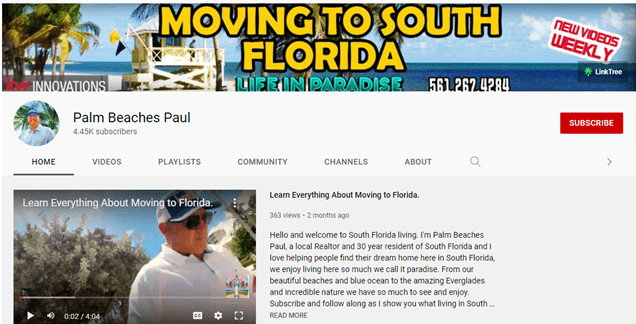





Talking about educational content, hosting webinars is also an excellent content marketing approach. 89% of businesses believe webinars outperform other digital channels in generating qualified sales leads.
So, invest in webinars.
Remember, don’t talk about topics you want to talk about; Choose webinar topics according to what your audience wants to listen to.
Finally, consider guest-writing articles on relevant real estate websites, local blogs, and newspapers. Doing so will help build your authority and portray you as an industry expert.
Email marketing is one of the best ways to reach new prospects and keep the old ones engaged.
But before you can start doing it, you will have to build your email list.
Your email list should, ideally, comprise people who have been your clients, or those who are most likely to become your clients in the future.
There are many ways you can build your email list, like:
Here’s an example from one of the top realtors in the Jersey City area of a website banner to generate email addresses for email marketing (don’t miss out on the note at the bottom):






Sixty-seven percent of real estate buyers find agents through referrals from past clients.
Reviews are absolutely critical for your real estate business if you want to attract clients and keep your business going.
Gaining positive reviews is not too easy, though.
People are eager to leave a negative review but not so quick to write a positive one. Therefore, you will have to work hard to get reviews from your clients.
Consider reaching out to clients you have consulted with via email, requesting a review. Also, ask people you have closed deals with to leave a review.






If you have some clients who you have excellent relations with, ask them to participate in video testimonials that you can share on your social media and YouTube channel.
Reviews and testimonials are the ultimate trust signal.
Make gaining reviews a part of your real estate marketing strategy.
Real estate marketing, especially online marketing, is critical for the survival of any modern real estate business, whether small or large.
As you implement the marketing strategies discussed above, remember the importance of high-res visuals.
Include high-quality property images in your social posts, website, and everywhere you can.
Also, the marketing world evolves rapidly, so keep track of the changes in real estate marketing and adapt your strategy accordingly.
More resources:
Featured Image: Andrey_Popov/Shutterstock




We know that there are many reasons to focus on SEO from a commercial standpoint.
Working on your company’s SEO can help raise the quality of your website, your brand reputation, and your conversions.
But what about the impact on your team?
Having a good SEO strategy in place can actually benefit your company in other ways.
Colleagues’ jobs can be made easier.
They may be equipped with new skills.
It may even help prove the worth of their work.
There are many important ways in which SEO can impact other marketing channels.
But let’s take a look at how it can help those teams meet their personal and team goals.
A good SEO strategy will never be in isolation from other marketing channels.
Pay-per-click (PPC) advertising, for instance, goes hand-in-hand with SEO. Both channels’ leads need to talk to each other, or there’s going to be a financial impact.
The benefits go beyond money saving, though. SEO is a far-reaching specialism.
We need input on many other teams’ work: brand marketing, CRM, and paid media, to name a few. Through this, SEO can help to unify projects.
SEO professionals tend to need to be involved in anything that could affect the performance of the website – from brand positioning to content creation.
As such, SEO pros can be key stakeholders in marketing campaigns.
We help to ensure consistency in messaging and audience, both on-site and off.
SEO can assist with bringing a lot more users to your company’s digital assets, which, in turn, allows channels such as email marketing to promote sign-ups, or ecommerce managers to alert customers to offers.
Without the steady traffic of organic search, it can be hard for other marketing channels to gain enough of an initial audience for their campaigns to flourish.
Organic traffic is often one of the largest generators of traffic to a website.
When colleagues are looking to carry out user experience (UX) or conversion rate optimization (CRO) experiments, they will need a significant enough flow of traffic to be able to declare their experiment concluded.
SEO can be one of the ways qualified traffic is sent to those experiments without the additional cost of PPC or social media campaigns.
The data gathered through SEO can also be very helpful in giving other marketing channels a place to start with their own campaign ideation.
Through the Google Trends data into trending topics, your editorial team can understand what subjects to cover that will be of interest to your target audience.
The seasonality of your industry shown through the peaks and troughs of search term usage can indicate to your wider marketing team the impact their campaigns may have at different times of the year.
A quick search engine results pages (SERP) analysis can yield lots of information about what social posts or videos competitors are producing.
The reserved spaces in the search results for videos, images, news, and social media can be a goldmine of ideas for other marketing teams that they may not think to check.
SEO pros can help improve and maintain brand reputation.
Often, when a search is carried out for a company name, the first page of the search results is a mix of brand-owned and third-party websites. Because of this, SEO professionals have a huge impact on what visitors see when they are searching for a brand.
Negative Google Business Profile (GBP) reviews or a poor Tripadvisor score may be visible on the front page of the SERPs if a brand is having trouble with its online reputation.
SEO pros can work to bring owned properties up the search results for branded search terms, as well as work with customer success teams to respond to negative reviews.
This can help to make the branded search results more neutral (or even positive) for the brand.
SEO experts have to cover a lot of bases with their work.
They need to understand how the technology of the website they are working on impacts its performance. There is a requirement to understand how user behavior changes over time. They have to be ready to capitalize on trends.
As a result, SEO pros are in a great position to be able to share their knowledge with other teams outside of the marketing department.
Research into search terms potential visitors are using can sometimes reveal new revenue streams or product ideas.
When conducting keyword research for your industry, you may well discover that there is a lot of interest in an idea or topic that is very related to your current product offering.
This insight can be shared with product teams to help them explore interest in new products.
This research can also be used to test the interest in a product in new markets.
For example, if your or a client’s business is considering expanding internationally, then research carried out by SEO pros can indicate receptiveness to a product in the new country.
Competitor analysis carried out by SEO professionals will often look at where there are gaps in the search market that competitors are filling.
This data can give product teams insight into how other relevant companies are better meeting the needs of your shared audience.
It can also show where there is little or no significant competition for a new product or service.
Speaking to the customer service team is often touted as a great source of topic ideas for SEO pros. However, finding out what questions and concerns the customer service team is working with daily can go beyond an article for the company blog.
Find out common customer issues now and provide resources online to alleviate those concerns.
This is especially beneficial to customer service teams that field many calls every day, and have long hold times.
It isn’t just for the benefit of getting more organic traffic to the website. It could be the difference between a happy or unhappy customer.
SEO professionals can optimize this content so it directly meets the needs of searchers looking for those answers. This makes the answer easier to find and stops them from having to call a customer service line.
It can also give SEO pros an understanding of what might appear as a “People Also Asked” question in relation to your brand if it is asked a lot, and therefore probably searched a lot.
Creating content that answers those frequently asked questions can help your customer success team’s workload, and also enable your site to be a possible contender for the People Also Asked result if one is provided.
It can be fairly obvious to see how SEO will impact other marketing channels and vice versa. However, have you stopped to consider quite how broad the impact of SEO is?
The skills involved in good SEO can have a much wider effect.
SEO is all about understanding our audience’s needs and how they go about solving their problems.
Through keyword research, we have a clear view of what our target market is looking for in relation to our products or services.
This information is incredibly valuable to sales teams.
It is a level of data they may not be able to access themselves, yet it provides great insight into the problems and concerns their customers are looking to solve.
Consider creating regular reports to your, or your client’s, sales teams that detail trending topics and frequently asked questions.
This data could help them to identify new hooks or solutions that will be directly relevant to your market.
This one might seem obvious.
We know SEO relies heavily on quality content creation – the data we can pull for keywords alone helps to ensure copy that’s more relevant to searchers.
But how can SEO help copywriters?
With the myriad of tools at our disposal, SEO experts can gain insights into trending topics, predict seasonal interests, and understand how to make copy resonate with readers.
All of this is very valuable to content creators.
Editorial Teams
Consider your editorial teams – they want to be creating content for your blog or video channel that will be found by new audiences.
SEO pros can help with that greatly, from recommending important search phrases to use, to video optimization to help them be more visible on Google Search and YouTube.
Product Copy
Beyond editorial, SEO can assist with ensuring product copy and service details are targeted to the language readers are wanting to see.
Keyword search data and competitive analysis can give insight into what features and information readers are interested in and therefore need to be highlighted.
SEO experts can also help copywriters to understand how search engines perceive the relevancy of their copy to their target audience’s needs.
After all, the likes of Google have spent considerable time and money ensuring the pages they rank will meet the needs of searchers. There is a lot of insight SEO pros can provide on what relevancy looks like.
One big way SEO can positively impact the work of other departments is by showing the value their work brings to SEO.
They will have their own metrics and key performance indicators (KPIs) they use to demonstrate the effectiveness of what they do.
SEO, however, is another channel they may be affecting – and proving the benefit of their work to the success of SEO is a great way of encouraging closer collaboration.
There will be several ways in which you can quickly identify the impact of other teams’ work on SEO.
Sometimes changes are made to websites, and the teams involved don’t know how to measure their success.
Increases in search visibility or organic traffic to those pages can be a good indicator that the change was a successful one.
SEO isn’t just about driving traffic to a website; that traffic needs to be converting.
Demonstrate to the teams involved that changes to the website have yielded a much higher conversion rate for organic traffic.
This can help to solidify the value of the work they have carried out.
Changes the engineering team has made to the website can drastically hinder or improve its ability to be crawled.
Crawl stats can detail the improvement in volume or type of pages being crawled. They can also show the reduction in cruft pages being crawled.
It can be a good analysis to demonstrate the success of recent development changes. Similarly, look at how pages are being indexed over time.
Seeing that the right ones are indexed (and the wrong ones aren’t) can be a success indicator for recent development changes.
This is a metric that most developers are probably keeping an eye on themselves.
However, it can be a good one to share with those that aren’t.
Improving page speed can be a positive change for SEO purposes and user experience.
SEO has a very obvious benefit to companies. More traffic, more leads or sales, and more revenue.
Beyond this, SEO can help other departments of a business be more efficient.
As SEO pros, we shouldn’t be afraid to provide insight to other teams.
It might be valuable to them and can help them to demonstrate their own successes to the broader organization.
More resources:
Featured Image: PeopleImages.com – Yuri A/Shutterstock
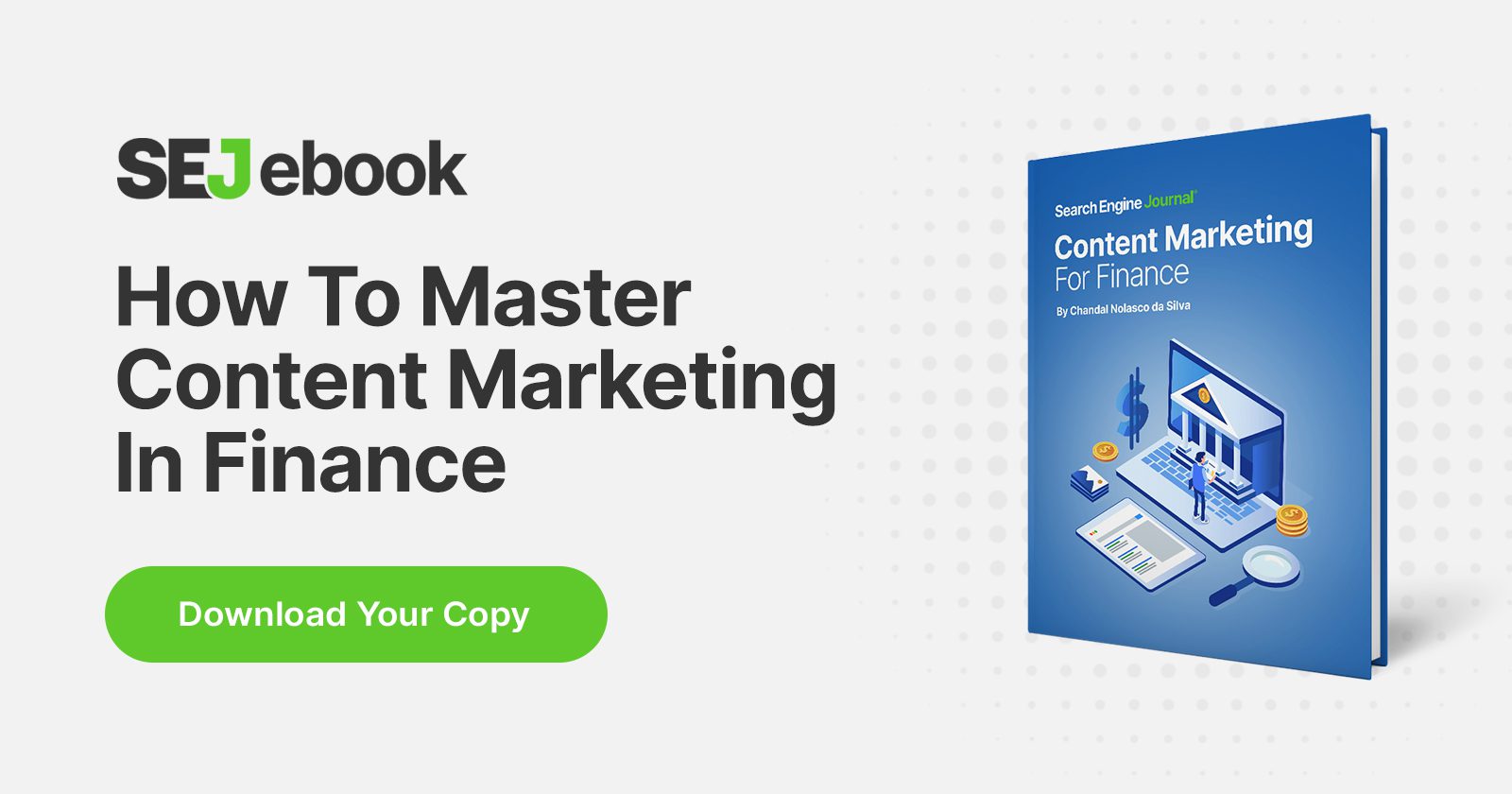
As a financial service business, you’re facing a unique set of challenges when it comes to creating content.
So, how can you overcome these challenges to form an effective content strategy?
How do you create finance content that’s responsible and accurate yet still compelling and convincing?
Our new ebook, Content Marketing For Finance, walks you through how you can develop a content strategy that respects the rigorous demands of the financial space while truly connecting with your target audience.
“Audience is at the heart of every content marketing strategy and should always be kept top of mind,” writes author Chandal Nolasco da Silva.
Download your copy and learn how to meet your customers at each stage of their journey and create the kind of content that consistently converts.
This pocket guide has all the insights you need to navigate the ins and outs of content marketing within the finance industry.
Topics covered include:
The contents of this marketing ebook can help you navigate complex issues, such as the:
If you’re a financial service professional looking to step up your content strategy for 2023, download the ebook now!



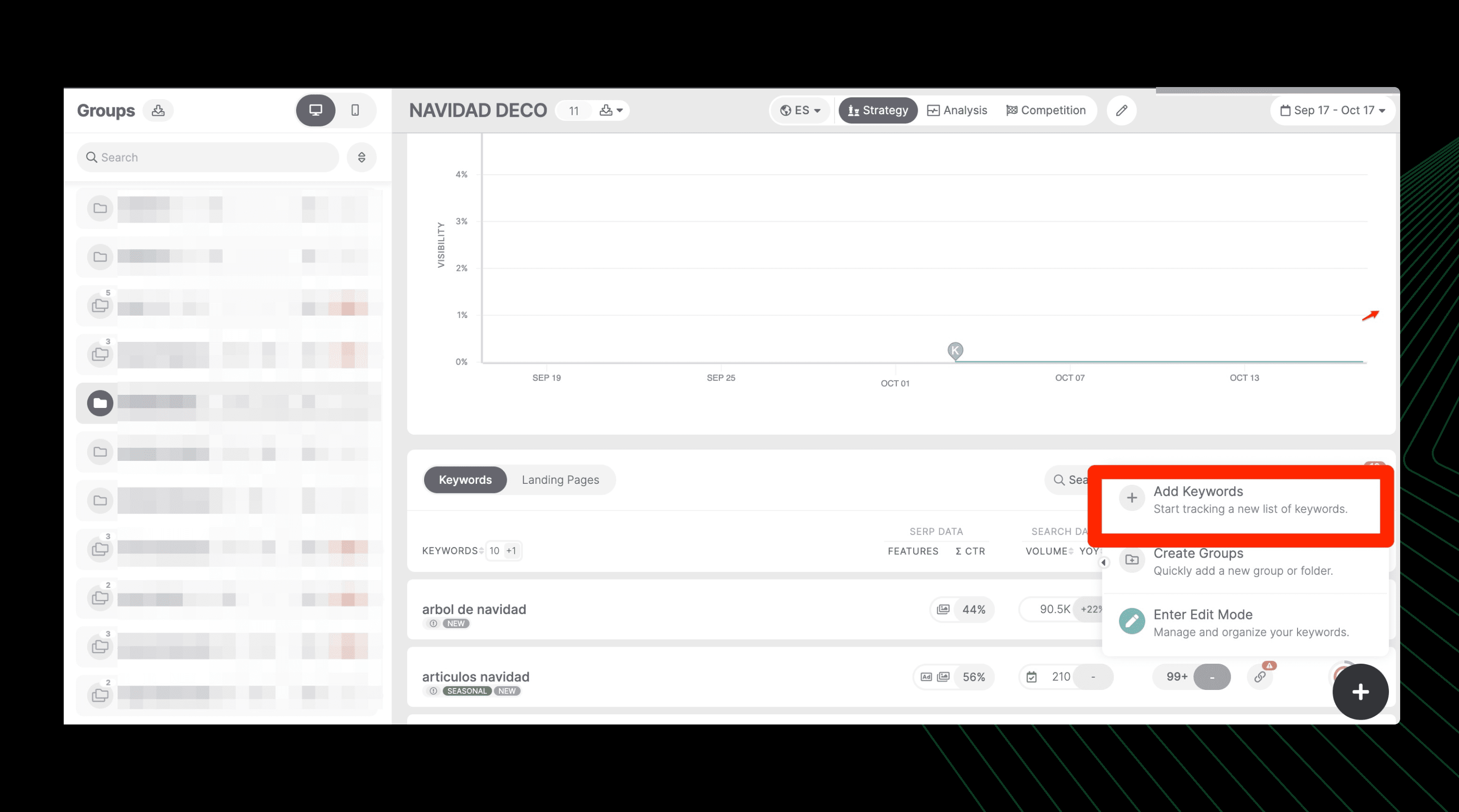
At Estudio34, we have a powerful mix between SEO and PPC, which helps us be more effective at optimizing spending and targeting.
So, start by building a communication plan before creating your next digital strategy. Focus on leveraging some of the learnings from one another.
First, you and your teams should ask yourselves:
Once everyone from your SEO and PPC teams has provided answers, it will be easy to create the perfect roadmap of keywords for each team.
Sometimes, it’s easier to learn by example, so let’s travel through a real marketing problem that we had to solve.
In this instance, a grocery retail client had a simple yet very common problem: a high dependency on branded and non-branded terms in their paid campaigns.
The client’s objective was to leverage their SEO efforts in order to reduce exposure on paid channels.
The hypothesis was that if you target key PPC terms you could easily get organic visibility for, you could stop bidding on them and consequently stop cannibalizing SEO through paid search.
It is worth stating that, in our case, there was a huge dependency on branded terms. As you may have experienced, spending on PPC keywords for which you have good organic rankings can make good business sense to protect coverage on a more crowded SERP.
In order to illustrate it in a very simplistic manner, this is how PPC keyword targeting versus SEO would normally be set:
The SEO Strategy
We try to define specific terms (AKA: chunky middle, even long tail), and we move towards broader terms (AKA: Generics), thus grouping many keywords in buckets (groups in SEOmonitor).
Ex.: Wooden toy kitchen: Global Search Volume 11.4K
The PPC Strategy
We try to define broader terms (AKA: broad match), and we move towards specific terms (AKA: exact match), thus grouping many keywords in buckets (AdGroups).
Ex.: Wooden toys OR Toys: Global Search Volume 53.5K
The Result
You can see that one will be more specific (PPC) over time, whilst the other is specific from day one but relies on getting good visibility in order to harness any impact.
The next thing to uncover is what happens when you have good visibility (rankings) for it.
These steps are the real, proven pathways to how the Estudio34 team combined SEO and PPC data to improve their search visibility while optimizing budgets for both channels.
Once you’ve made it to this method, you and your PPC team should be actively communicating and sharing data.
Without actively collaborating with your PPC team, you might not even be aware of cannibalization issues.
In this context, cannibalization refers to SEO and PPC targeting the same keywords and competing for traffic instead of being leveraged together. When that happens, search results might include your own competing landing pages, which can lead to lower conversions or dispersed traffic.
Where Does Cannibalization Often Occur?
PPC teams might bid on terms without knowing the SEO side. Or SEO professionals might inherit this structure from day one without realizing it’s happening.
Because the point of this strategy is to benefit cross-channel through keyword overlap, we started the analysis from paid keywords to then cross-reference with SEO data.
How We Stopped SEO & PPC Keyword Cannibalization
First, we pulled a list of PPC terms that were generating clicks and no conversions over a period of three months – this allows you to group them by search queries (SQR report).
Note that the timeframe may differ from business to business due to the volume of data and actual spending in the given period. You should test with date ranges to see how many terms meet the criteria. You don’t want to be swamped in rows of data, but rather have actionable and measurable options.
To solve the “not provided” issue and get conversion data at the keyword level, our team at Estudio34 leveraged SEOmonitor’s Organic Traffic module. SEOmonitor brings all the keyword data from Search Console enriched with sessions and conversions from Analytics by using their common ground: the landing page.
Once we had the hit list from the PPC team, we uploaded these to the rank tracker as new keywords.






We recommend doing this in a separate group, mainly because the visibility for the group can be measured and excluded from potential forecasts if needed.
Next, it was time to identify overlaps.
For our case, we looked at keywords in position 3 or above.
We did it manually as we didn’t want new terms to be added unless we said so, but in SEOmonitor, you can set smart groups, meaning that anything that falls into your filtering option will be automatically added and updated.
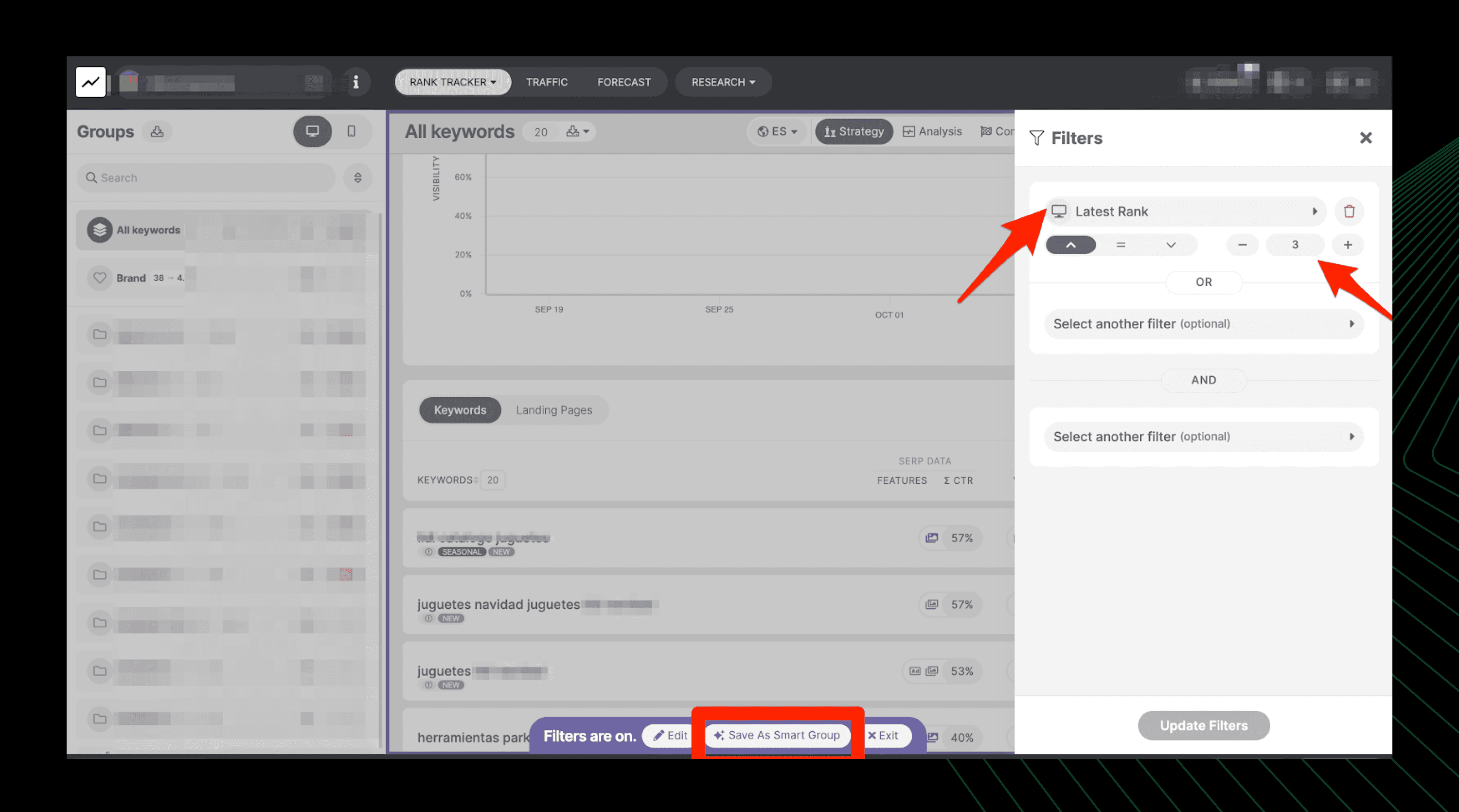





We continued our filtering in SEOmonitor’s rank tracker so as to leave out keywords that also have an ad showing for them.
Theoretically, this check is unnecessary because we pulled out the terms from PPC campaigns.
However, it’s good to know in case you need to do it the other way around. Bear in mind that certain terms may not be picked up in some instances as it depends on your aggressive bidding and when the tool snapshots the SERPs.
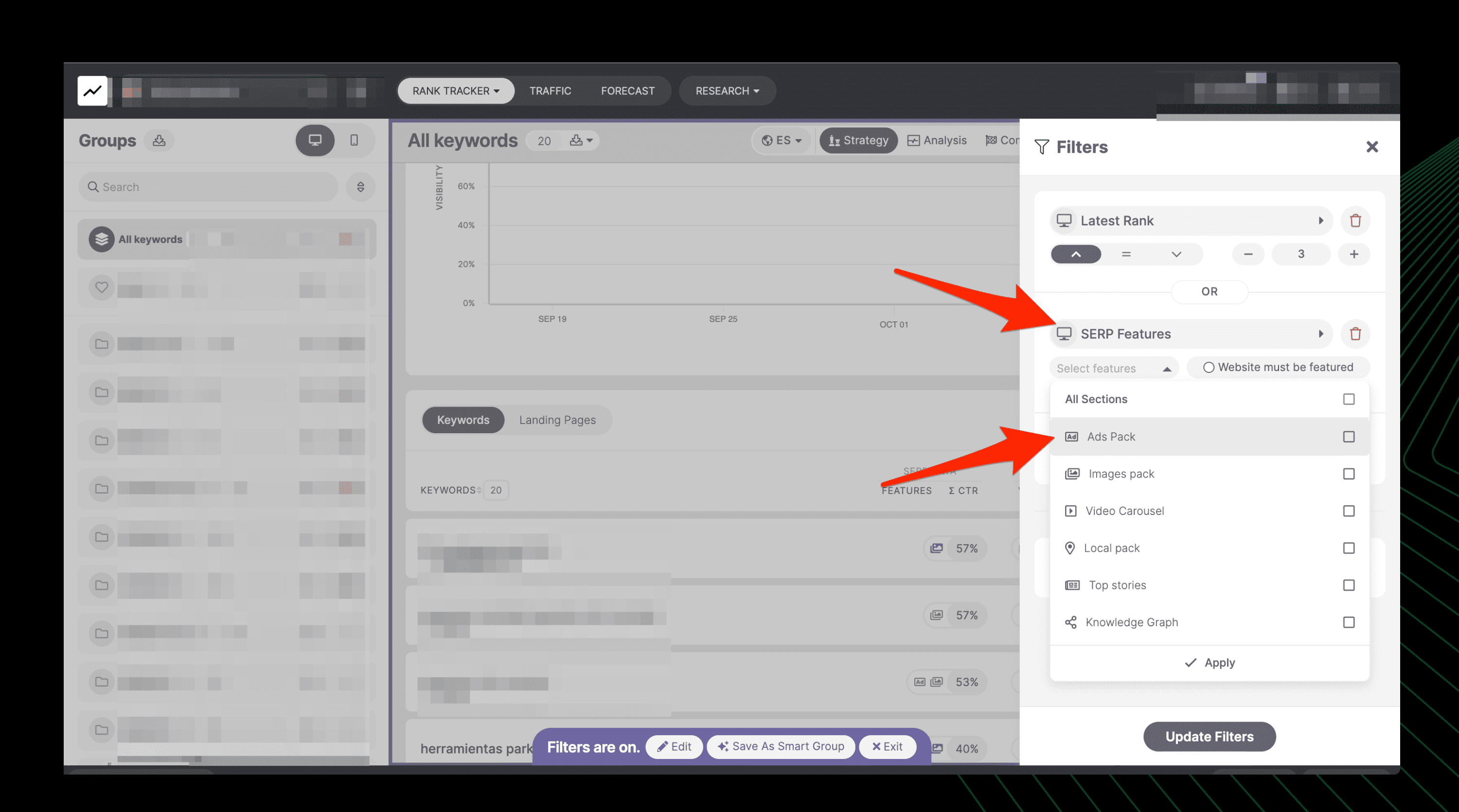





Over time, you’ll also get Seasonality, and SERP Features Visibility details.
These are incredibly useful because whatever terms you decide to test may well have no impact if, seasonally speaking, they are not relevant.
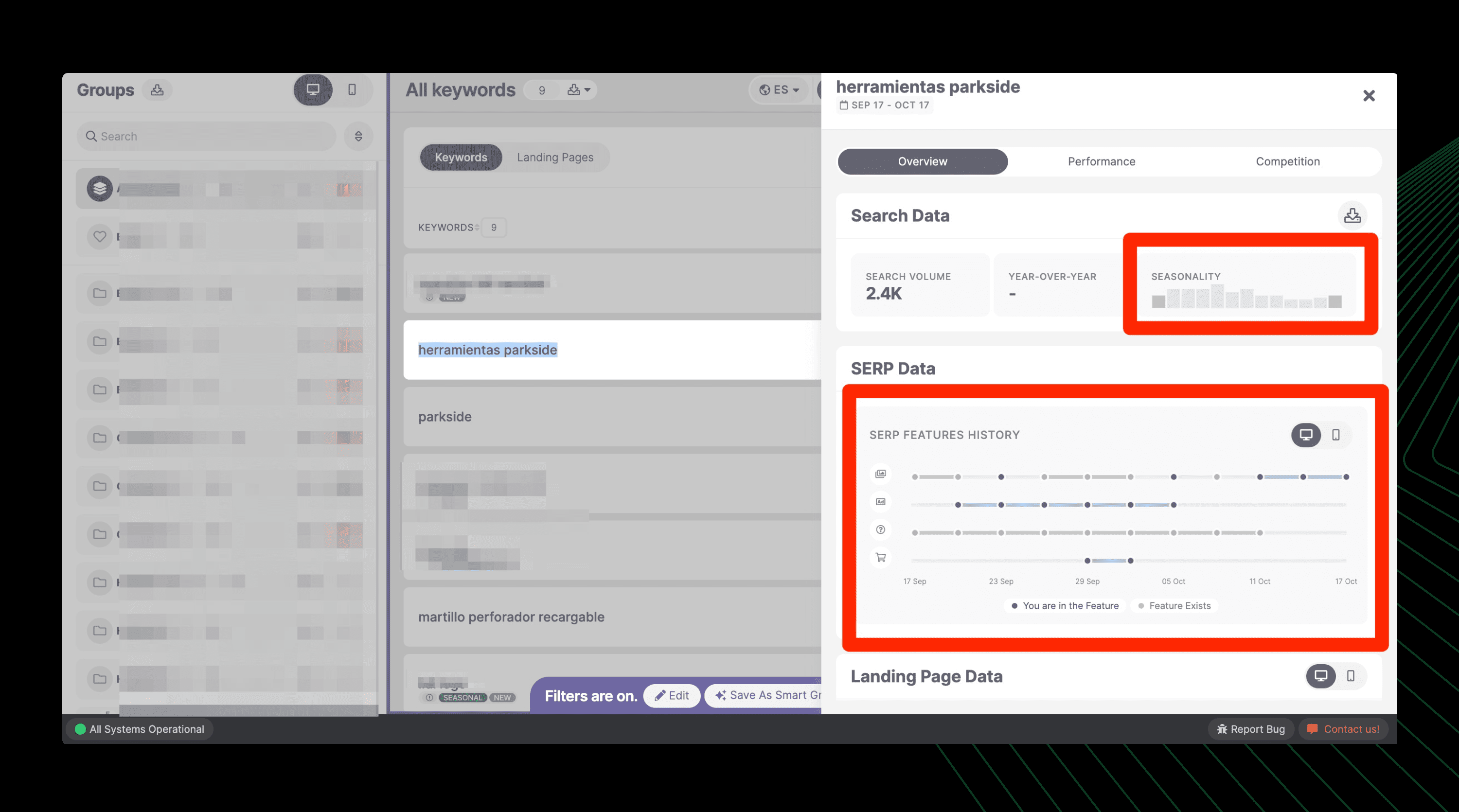





Start by defining the landing page for which a certain query ranks.
The landing page will help determine how much traffic was coming to it organically and thus if it increases or decreases. Likewise, we can assess conversions that may have been generated from that landing page. Note that we are making concessions, as there are cases where a landing page may be serving the discovery phase purely, so conversions may not affect the overall result.
Now, you can start testing.
You may be tempted to pause campaigns to see the impact on organic traffic. However, this is not advised, mainly because you could be affecting your top line. How you go about it can help mitigate any risk associated with revenue loss.
Target individual keyword testing by:
Because we have the organic traffic to the ranking URL, we have a snapshot of the before and after effects of negatively excluding keywords from PPC campaigns.
Compare the following for the timeframe tested versus the previous period:
Look for patterns like:
What to do based on the previous patterns:
Retain the excluded terms if all three instances are met positively – meaning:
If there are what-ifs involved and the client has concerns, here’s what to do:
Tackle concerns with an actual agreed-upon action plan.
As a means of mitigating potential sales loss, the first question to ask is if SEO traffic converts worse than when targeting the query on paid. Our recommended action was to revert back to that term and dig into specifics: Are the landing pages the exact same? What can be taken from the paid campaign to improve UX on the SEO page?
This is where the second benefit of this activity comes to play: leveraging the on-page optimization and clear targeting of a landing page used in PPC to target an SEO term and landing page, as follows:
With this client, we learned that the best results came from switching the exact terms that included the brand. Mainly because they had a competitive cost and good conversion rates.
With generic terms, the results were a mixed bag. Yet it’s reasonable to state that on expensive terms, if you have good SEO, it will be an almost certain win.
For this client, we targeted a test with 1,300 terms with an average cost per click of 0.12 euros. Generating 20,000 clicks over the two weeks tested saved around 4,800 euros per month.
As we saw from Smith and the team at Estudio34, taking an integrated approach to SEO and PPC might be useful for data-driven experiments and cutting waste on both channels through:
With SEOmonitor’s data granularity (daily ranks for desktop and mobile as standard) and solution to the not provided, the agency could zero in on SEO performance and understand every change.
Plus, having advanced filtering capabilities, they could set up a mix of groupings to track carefully.
This is just one of the many ways SEO professionals leverage SEOmonitor to be more effective in their workflows.
Join us, and agencies like Estudio34, in our quest to help SEO professionals focus on what matters.